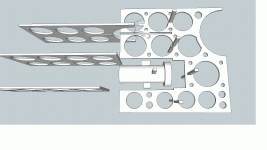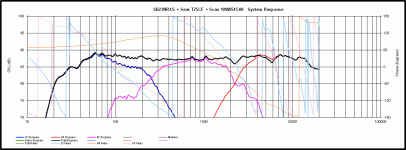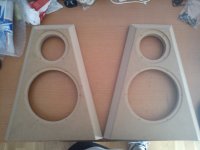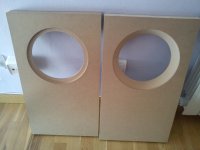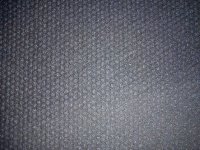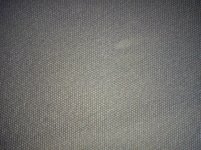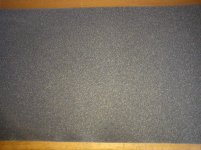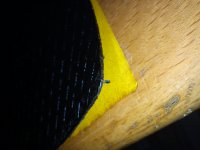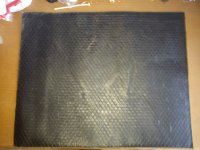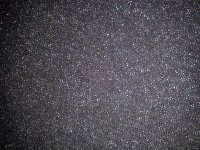Wich kind of damping material and how/where to use it?
Damping materials • Covering • Europe Audio
Damping materials • Filling • Europe Audio
Attached pics 4mm mdf front panels
Damping materials • Covering • Europe Audio
Damping materials • Filling • Europe Audio
Attached pics 4mm mdf front panels
Attachments
You want to treat the upper and lower cabinets differently and there are any number of different materials you could use to do so. Choices can depend on availability and how much money you want to spend.
Here is some good info - Cabinet-damping
The upper cab is vented right now but I suggest sealing it by stuffing the port. This now gives you extra volume to work with. I would glue some kind of bitumen pads to the sides, top, bottom and back walls, like these, BITUMEX/FG4 - BITUMEX FG 4 SK 245 x 325 x 4.0 mm - Europe Audio.
Then I would use about 8 to 10L of very high density fiberglass insulation to absorb as much of the mid's backwave as possible. So maybe about 100-125mm from the back of the cab will be completely stuffed and then something like 50mm on the sides and maybe 50-75mm on the top and bottom. Leave about 5 to 7L directly behind the driver empty.You may want to experiment with this and see what sounds best to your ears.
The higher the density, the more of the lower frequencies that get absorbed. I've used Roxul boards before like these, Roxul Mineral Wool Board (2" Thick 8#), which are 8lb/cf or over 100kg/m3. I bought more than needed and then used the left over to make acoustic wall panels and corner bass traps similar to ones here, RealTraps - Home.
You may not be able to find Roxul in Europe. Owens Corning 700 series acoustic panels are the most similar, for eg. Owens Corning 703 Fiberglass Acoustic Board 1" (3#), but look for the highest density available.
What's also popular these days is memory foam, available as mattress toppers and pillows. Not as dense as the above though but good stuff. Most similar to this kind of thing, TYROTEX/30/1 - Damping material 0.5 X 1M for 30kg/M3 - Europe Audio.
For the bass cab, I'm not sure I would use the bitumen pads on the walls because by adding mass to the walls, we reduce the resonant frequencies of the panels which sort of defeats one of the purpose of the bracing which is to raise the resonant frequencies. But a layer of felt (or carpet underlay) and then a layer of memory foam or acoustic foam should work well. But always leave a clear path between the port and the driver.
Baffles are looking good.
Here is some good info - Cabinet-damping
The upper cab is vented right now but I suggest sealing it by stuffing the port. This now gives you extra volume to work with. I would glue some kind of bitumen pads to the sides, top, bottom and back walls, like these, BITUMEX/FG4 - BITUMEX FG 4 SK 245 x 325 x 4.0 mm - Europe Audio.
Then I would use about 8 to 10L of very high density fiberglass insulation to absorb as much of the mid's backwave as possible. So maybe about 100-125mm from the back of the cab will be completely stuffed and then something like 50mm on the sides and maybe 50-75mm on the top and bottom. Leave about 5 to 7L directly behind the driver empty.You may want to experiment with this and see what sounds best to your ears.
The higher the density, the more of the lower frequencies that get absorbed. I've used Roxul boards before like these, Roxul Mineral Wool Board (2" Thick 8#), which are 8lb/cf or over 100kg/m3. I bought more than needed and then used the left over to make acoustic wall panels and corner bass traps similar to ones here, RealTraps - Home.
You may not be able to find Roxul in Europe. Owens Corning 700 series acoustic panels are the most similar, for eg. Owens Corning 703 Fiberglass Acoustic Board 1" (3#), but look for the highest density available.
What's also popular these days is memory foam, available as mattress toppers and pillows. Not as dense as the above though but good stuff. Most similar to this kind of thing, TYROTEX/30/1 - Damping material 0.5 X 1M for 30kg/M3 - Europe Audio.
For the bass cab, I'm not sure I would use the bitumen pads on the walls because by adding mass to the walls, we reduce the resonant frequencies of the panels which sort of defeats one of the purpose of the bracing which is to raise the resonant frequencies. But a layer of felt (or carpet underlay) and then a layer of memory foam or acoustic foam should work well. But always leave a clear path between the port and the driver.
Baffles are looking good.
There is a local distributor of Roxul | Decó | - Productes is the same product?
It's hard for me to tell exactly, names are different over here, however yes it does look like the right thing.
After looking at the data sheets for the listed products, I would probably go with either the Rockcalm E-211 (40kg/m3) or the Alpharock E-225 (70kg/m3):
http://www.deco.cat/Arxius/ROCKCALM211-200702260953263.pdf
http://www.deco.cat/Arxius/ALPHAROCK225-200702231603252.pdf
Sound absorption coefficient curves look different but it's hard to compare them because the graphs are for different thickness samples (low frequency absorption increases with thickness). I think they're pretty similar though. In that case, go with the less expensive one. I might choose the 30mm thickness. One layer of this alone on the walls might also work in the bass cabinet too (ie. no felt layer). I'm not totally sure though because I've only used it in a sealed box and in acoustic panels.
That's a large quantity in 1 package by the way. More than enough for 2 speakers I think. That's why I would also think about making a couple of acoustic panels with the left overs too if you end up buying some. A 90mm thickness would work well here.
Wear gloves, long sleeves and a little breathing mask when working with it. It cuts up easily with a sharp knife.
After looking at the data sheets for the listed products, I would probably go with either the Rockcalm E-211 (40kg/m3) or the Alpharock E-225 (70kg/m3):
http://www.deco.cat/Arxius/ROCKCALM211-200702260953263.pdf
http://www.deco.cat/Arxius/ALPHAROCK225-200702231603252.pdf
Sound absorption coefficient curves look different but it's hard to compare them because the graphs are for different thickness samples (low frequency absorption increases with thickness). I think they're pretty similar though. In that case, go with the less expensive one. I might choose the 30mm thickness. One layer of this alone on the walls might also work in the bass cabinet too (ie. no felt layer). I'm not totally sure though because I've only used it in a sealed box and in acoustic panels.
That's a large quantity in 1 package by the way. More than enough for 2 speakers I think. That's why I would also think about making a couple of acoustic panels with the left overs too if you end up buying some. A 90mm thickness would work well here.
Wear gloves, long sleeves and a little breathing mask when working with it. It cuts up easily with a sharp knife.
That's a decently sized room.
I asked because room size affects the low frequency response and that affects what I do with the xo. In the end though, you are going to be the one that has to do the listening and make any final adjustments. With any luck, it'll just be a few resistors that need changing but I'll show you exactly what does what and walk you through it as much as I am able.
I'll post a new xo for you shortly.
I asked because room size affects the low frequency response and that affects what I do with the xo. In the end though, you are going to be the one that has to do the listening and make any final adjustments. With any luck, it'll just be a few resistors that need changing but I'll show you exactly what does what and walk you through it as much as I am able.
I'll post a new xo for you shortly.
Self-adhesive bitumen pic + foam recommended for the local seller, I guess that will be not too mucho for the mid-high cabs two bitumen layers + one layer of 1cm of foam?
Attachments
How thick is the bitumen? Aim for about 4mm thick total.
Under normal circumstances, I'd say 1cm of foam might be adequate but your top cab is a different situation which is actually good. The volume is too large for a sealed enclosure so use extra higher density foam to fill it up as I explained previously and therefore do a better job of absorbing the backwave. The sound will be cleaner. So 10cm thick in the back (top to bottom) and 2-3cm on the side, top and bottom walls leaving the driver free to breath all the way around (so maybe scallop a little foam out right at the sides of the driver).
For the bottom cab, I would try it first without the bitumen. 25-30mm of foam on the walls (you could try it with or without felt) should probably work fine.
Under normal circumstances, I'd say 1cm of foam might be adequate but your top cab is a different situation which is actually good. The volume is too large for a sealed enclosure so use extra higher density foam to fill it up as I explained previously and therefore do a better job of absorbing the backwave. The sound will be cleaner. So 10cm thick in the back (top to bottom) and 2-3cm on the side, top and bottom walls leaving the driver free to breath all the way around (so maybe scallop a little foam out right at the sides of the driver).
For the bottom cab, I would try it first without the bitumen. 25-30mm of foam on the walls (you could try it with or without felt) should probably work fine.
- Status
- This old topic is closed. If you want to reopen this topic, contact a moderator using the "Report Post" button.
- Home
- Loudspeakers
- Multi-Way
- Help for 3 or 4 way loudspeaker
